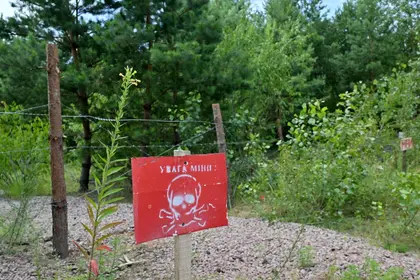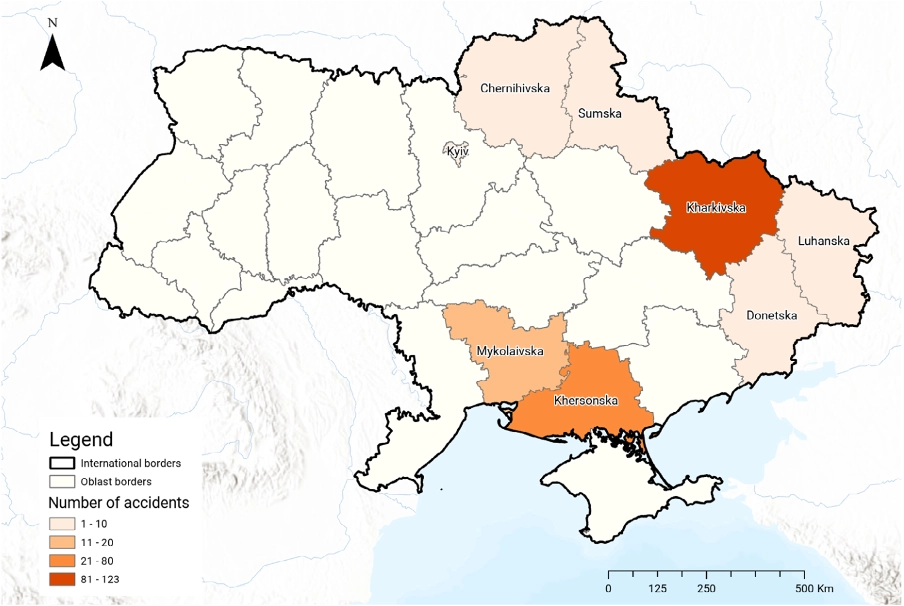The latest report by the Geneva-based independent analysis provider, The Assessment Capacities Project (ACAPS), gives a stark assessment of the extent of landmines and explosive remnants of war (ERW) contamination and the short, medium and long-term prognosis for its impact on Ukraine.
ACAPS readily admits that its findings are based primarily on secondary sources, because the NGO has limited access to many areas particularly those under control of the Russian military or its proxies – which equates to almost 20 percent of Ukraine.
JOIN US ON TELEGRAM
Follow our coverage of the war on the @Kyivpost_official.
OVERVIEW
The report reinforces the view that Ukraine is probably the most landmine impacted country in the world, with estimates that over 170,000 square kilometers or 29 percent of its territory is affected. The laying of mines and presence of ERW began in 2014 at the time of the original Russian led incursions into Crimea and the Donbas. The problem has increased exponentially since Russia’s full-scale 2022 invasion.
ACAPS map of most affected areas – based on casualty levels

Kharkiv Success: HUR Units Clear Russian Forces from 400 Hectares of Forest
The report cites the extensive use of antipersonnel landmines (APL) by both Russian and Ukrainian forces. It says that Russia has used at least 13 different types of APL including those with special “proximity” sensors as well as improvised and remotely delivered mines laid as they retreated from occupied areas.
Ukraine has also used APL in 2022, most notably in Izyum while under Russian occupation, but much of the city was cleared of theses and large quantities of ERW after liberation.
With the findings of this report, it must also be acknowledged that the war continues, and as further areas are freed or re-occupied the use of landmines will continue and the size of the problem will increase. The Armed Forces of Ukraine (AFU) has already acknowledged that it is preparing defensive positions including the laying of minefields to repel any future Russian offensive.
SUMMARY OF KEY FINDINGS
Casualty rates – there have been as many casualties since February 2022 as there was between 2014–2021 with most occurring in areas where Ukraine has regained control.
Affected people – rural populations, rescue workers, deminers, and humanitarian volunteers are the most affected groups. Adults of working age are most at risk with accidents occurring as a result of seasonal sowing, land clearing, electrical infrastructure repair and demining operations.
Affected areas – 11 of Ukraine’s 27 regions are contaminated preventing access to agricultural land, key transport routes and obstructing delivery of humanitarian aid.
Mine incident locations – the areas target by Russian forces is reflected in the locations where mine accidents occur with more than half in residential areas and on roads followed by agricultural and forested areas.
Affected population – Over ten million live in areas of Ukraine need mine action assistance with less than a third targeted for help in 2023 being reached.
Impact on food security and agriculture – it is estimated that more than ten percent of Ukraine’s agricultural land, around five million hectares, has been put out of use by the presence of mines and the same quantities lie under Russian control.
This land inactivity has resulted in total production losses of $4.3 billion since 2014 with another $1 billion in losses of machinery and equipment.
Limitations on mine action support:
- Ongoing fighting – the greatest need for mine action is in areas close to active hostilities but is prevented or limited by ongoing shelling and where re-contamination occurs as forces retreat or advance.
- Lack of resources – limited funding, shortage of demining experts legal, bureaucratic, and other financial obstacles.
Financial impact – landmine contamination is hitting the national economy particularly agricultural and dairy sectors along with sea mines blocking Black Sea ports for both import and export.
Demining challenges – combination of the scope and scale of the problem, shortage of funding, developing and certifying mine action assets, and access to contaminated areas.
MAIN CHALLENGES
The ACAPS report says that demining will play an integral part in Ukraine’s economic and social recovery. Currently the limited mine action activity being undertaken is constrained by active hostilities and the presence of Russian troops in the areas where it is most needed.
Clearance rates
As with many before them ACAPS suggests that it could take several decades to clear the landmines threat, even with additional national and international mine action responders and innovative technology accelerating the process.
Of the estimated 174,000 square kilometers of mine-affected territory less than 3,000 of the less contaminated land had been cleared by the end of 2023.
Funding
Mine clearance is extremely expensive. Estimates by the Government of Ukraine indicate clearance costs of between $2 and $8 per square meter, which would require almost $40 billion over the next ten years which could only start to be met with considerable international financial assistance.
This against a background of less than 25 percent of the requested funding for mine action having been provided in 2022.
Mine clearance standards
All clearance operations must be conducted in line with international mine action standards (IMAS) which are subject to additional national certification, which can be a slow procedure particularly as Ukraine currently lacks the resources, manpower or experience to manage the process. In 2023, the Interagency Working Group on Humanitarian Demining simplified permits for explosive work in demining during martial law and adopted a measure to speed up the government certification process for mine action responders
Access constraints
As liberated areas become accessible the demand for clearance assets to allow humanitarian activities the return of displaced persons, restoration efforts grows and cannot often be matched by the available resources. Active hostilities continue to challenge clearance activities and access to border areas.
MINE LEGISLATION COMPLIANCE
ACAPS pointed out that Ukraine is a signatory of the 1997 APL mine ban treaty and to the 1980 convention on certain conventional weapons (CCCW) and its amendments while Russia has not signed the APL treaty but is bound by the CCCW which was signed by the Soviet Union.
The indiscriminate use of APL, victim-operated booby-traps, improvised explosive devices and other weapons such as cluster munitions and phosphorous bombs against civilian areas by Russian forces is considered to constitute several violations of Moscow’s obligations under international law.
Both Russia and Ukraine have used at least 13 different anti-tank mines during the war to damage or destroy vehicles, including tanks and armored vehicles which, while not a violation as such, the placing of them in unmarked and unrecorded locations presents a long-term threat to civilians which could be construed as a humanitarian violation.
The use by Ukraine’s Armed Forces of rocket delivered APL into Russian-controlled areas and near Russian military facilities in Izium city, Kharkiv region is violation of the 1997 APL which Ukraine could argue has been mitigated by the efforts it has made to conduct clearance in those areas.
The landmine and ERW threats grow daily and there is no easy solution. It will directly impact those in the highly contaminated south and east of the country but the whole of Ukraine for decades if not generations to come.
You can also highlight the text and press Ctrl + Enter







